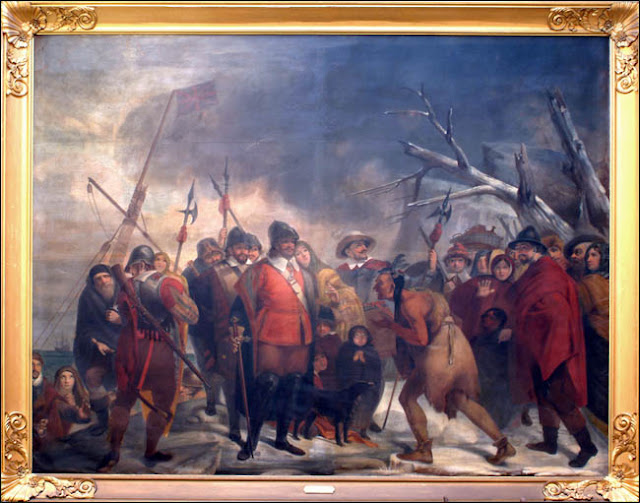Sargent’s "Landing of the Pilgrims"
Posted at Pilgrim Hall Museum:
The 17th-century Pilgrims are known through the writings and artifacts they left behind. There is much more to their history, however, than the 17th-century facts. There is also the "Pilgrim Story." That "Story" is the celebration of a few selected moments which have fixed the Pilgrims firmly in America's collective memory.This Pilgrim Story has grown and evolved over time. As each succeeding generation looked to the past for inspiration and guidance, certain key elements of the 17th-century Pilgrims were emphasized. The attention focused on these key elements has sometimes obscured other parts of the Pilgrim Story, changing the perception of the Pilgrim experience. Often, these later interpretations of the 17th-century Pilgrims tell us less about the Pilgrims than about the emotional and political needs of the era in which the interpretations were created.
As you scroll through the subject headings listed below, you will encounter key elements of the Pilgrim Story that have been celebrated in stories and in paintings: the Mayflower Compact, the Landing, the First Thanksgiving at Plymouth. Each of the elements of the Pilgrim Story is based on 17th-century facts. Each element has also received layers of interpretations and celebrations. These later interpretations are also history -- America's history of the 18th, 19th, 20th, and now 21st centuries.
We invite you to search through the layers of retelling to find the foundation of the 17th century. Where does it all begin? And where does it end? You might be surprised!
- Who were the Pilgrims?
- Religion
- Pilgrims in Holland
- The "Pilgrim Press"
- The Voyage of the Mayflower & Speedwell
- It Came on the Mayflower?
- The Mayflower Compact
- The Landing of the Pilgrims in America
- Who were the Native People?
- Samuel Champlain’s 1605 Map & Description of Plymouth Harbor
- The "First Thanksgiving" at Plymouth
- Financing and Building the Colony
- The Sparrow-Hawk
- Leadership in Plymouth Colony
- The Colony Becomes a Community
- Native People: Religion and Land
- King Philip's War & the Continued Presence of Native People
- Affluence & Style
- The End of Plymouth Colony
HT: Steve Lefemine, director of Columbia Christians for Life
